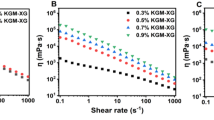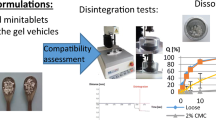Abstract
Purpose
The purpose of the present study was to investigate the effect of food viscosity on the dissolution rate of a drug. There are two types of viscosity, macroviscosity and microviscosity. Macroviscosity affects the diffusion layer thickness, whereas microviscosity affects the molecular diffusion coefficient. The mass transfer coefficient (kc) in the intrinsic dissolution rate (IDR) depends on the viscosity (η) as kc ∝ ηa (a is an exponent on η). In theory, for rotating flow over a disk, if a thickener increases only macroviscosity, a = -1/6, and if it increases both macroviscosity and microviscosity equally, a = -7/6.
Method
Benzocaine was used as a model drug. Hydroxypropyl cellulose (HPC) and methylcellulose (MC) were employed as control thickeners that increase only macroviscosity. Sucrose was employed as a control thickener for both macroviscosity and microviscosity. The FDA breakfast homogenate (BFH) was diluted with distilled water or 1 mM HCl with/without pepsin digestion. The IDR value was measured by the paddle-over-disk method.
Results
The η value of 30% BFH distilled water was 209 mPa∙s, about 300 times higher than distilled water. It was further increased by HCl (430 mPa∙s), and reduced by pepsin digestion (35 mPa∙s). The kc value was little affected by BFH (a = 0.00 to -0.09), slightly less than those in HPC (a = -0.19) and MC (a = -0.21). Sucrose decreased the kc value more significantly (a = -0.70).
Conclusion
The IDR and kc values of benzocaine were little affected by BFH, suggesting that BFH increased only macroviscosity.




Similar content being viewed by others
Data Availability
The data of this study are available on request from the corresponding author.
References
Nicolaides E, Symillides M, Dressman JB, Reppas C. Biorelevant dissolution testing to predict the plasma profile of lipophilic drugs after oral administration. Pharm Res. 2001;18:380–8.
Klein S. The use of biorelevant dissolution media to forecast the in vivo performance of a drug. AAPS J. 2010;12:397–406.
Sugano K. Biopharmaceutics modeling and simulations: theory, practice, methods, and applications. John Wiley & Sons; 2012.
Li M, Zhao P, Pan Y, Wagner C. Predictive performance of physiologically based pharmacokinetic models for the effect of food on oral drug absorption: current status. CPT Pharmacomet Syst Pharmacol. 2018;7:82–9.
Akiyama Y, Ito S, Fujita T, Sugano K. Prediction of negative food effect induced by bile micelle binding on oral absorption of hydrophilic cationic drugs. Eur J Pharm Sci. 2020;155:105543.
Yamaguchi T, Ikeda C, Sekine Y. Intestinal absorption of a. BETA.-adrenergic blocking agent nadolol. II Mechanism of the inhibitory effect on the intestinal absorption of nadolol by sodium cholate in rats. Chem Pharm Bull (Tokyo). 1986;34:3836–43.
Barnwell SG, Laudanski T, Dwyer M, Story MJ, Guard P, Cole S, et al. Reduced bioavailability of atenolol in man: the role of bile acids. Int J Pharm. 1993;89:245–50.
Kawai Y, Fujii Y, Tabata F, Ito J, Metsugi Y, Kameda A, et al. Profiling and trend analysis of food effects on oral drug absorption considering micelle interaction and solubilization by bile Micelles. Drug Metab Pharmacokinet. 2011;26:180–91.
Berginc K, Trontelj J, Kristl A. Bio-relevant media to assess drug permeability: Sodium taurocholate and lecithin combination or crude bile? Int J Pharm. 2012;429:22–30.
Alvarez-Lorenzo C, Gomez-Amoza JL, Martınez-Pacheco R, Souto C, Concheiro A. Microviscosity of hydroxypropylcellulose gels as a basis for prediction of drug diffusion rates. Int J Pharm. 1999;180:91–103.
de Smidt JH, Offringa JC, Crommelin DJ. Dissolution kinetics of theophylline in aqueous polymer solutions. Int J Pharm. 1991;77:255–9.
Radwan A, Ebert S, Amar A, Münnemann K, Wagner M, Amidon GL, et al. Mechanistic understanding of food effects: water diffusivity in gastrointestinal tract is an important parameter for the prediction of disintegration of solid oral dosage forms. Mol Pharm. 2013;10:2283–90.
Radwan A, Amidon GL, Langguth P. Mechanistic investigation of food effect on disintegration and dissolution of BCS class III compound solid formulations: the importance of viscosity. Biopharm Drug Dispos. 2012;33:403–16.
Parojčić J, Vasiljević D, Ibrić S, Djurić Z. Tablet disintegration and drug dissolution in viscous media: Paracetamol IR tablets. Int J Pharm. 2008;355:93–9.
Nelson KG, Shah AC. Mass transport in dissolution kinetics I: Convective diffusion to assess the role of fluid viscosity under forced flow conditions. J Pharm Sci. 1987;76:799–802.
Dokoumetzidis A, Macheras P. A century of dissolution research: From Noyes and whitney to the biopharmaceutics classification system. Int J Pharm. 2006;321:1–11.
Sugano K. Aqueous boundary layers related to oral absorption of a drug: From dissolution of a drug to carrier mediated transport and intestinal wall metabolism. Mol Pharm. 2010;7:1362–73.
Avdeef A, Tsinman K, Tsinman O, Sun N, Voloboy D. Miniaturization of powder dissolution measurement and estimation of particle size. Chem Biodivers. 2009;6:1796–811.
Tseng Y-C, Patel M, Zhao Y. Determination of intrinsic dissolution rate using miniaturized rotating and stationary disk systems. Dissolution Technol. 2014;21:24–9.
Klein S, Dressman JB, Butler J, Hempenstall JM, Reppas C. Media to simulate the postprandial stomach I. Matching the physicochemical characteristics of standard breakfasts. J Pharm Pharmacol. 2004;56:605–10.
Kong F, Singh RP. Disintegration of solid foods in human stomach. J Food Sci. 2008;73:67–80.
Braun RJ, Parrott EL. Influence of viscosity and solubilization on dissolution rate. J Pharm Sci. 1972;61:175–8.
Marciani L, Gowland PA, Spiller RC, Manoj P, Moore RJ, Young P, et al. Effect of meal viscosity and nutrients on satiety, intragastric dilution, and emptying assessed by MRI. Am J Physiol-Gastrointest Liver Physiol. 2017;280:G1227–33.
Benini L, Castellani G, Brighenti F, Heaton KW, Brentegani MT, Casiraghi MC, et al. Gastric emptying of a solid meal is accelerated by the removal of dietary fibre naturally present in food. Gut. 1995;36:825–30.
Macheras P, Koupparis M, Antimisiaris S. An in vitro model for exploring CR theophylline-milk fat interactions. Int J Pharm. 1989;54:123–30.
Macheras P, Koupparis M, Apostolelli E. Dissolution of 4 controlled-release theophylline formulations in milk. Int J Pharm. 1987;36:73–9.
Russell TL, Berardi RR, Barnett JL, Dermentzoglou LC, Jarvenpaa KM, Schmaltz SP, et al. Upper gastrointestinal pH in seventy-nine healthy, elderly, North American men and women. Pharm Res. 1993;10:187–96.
Dressman JB, Berardi RR, Dermentzoglou LC, Russell TL, Schmaltz SP, Barnett JL, et al. Upper gastrointestinal (GI) pH in young, healthy men and women. Pharm Res. 1990;7:756–61.
Nagasawa Y, Nakagawa Y, Kenmochi J. OKADA T. 1. Microscopic viscosity of aqueous solution of saccharides: a study by ultrafast pump-probe spectroscopy. Cryobiol Cryotechnol. 2003;49:87–95.
Hoshino S, Oike T, Yakura H. Diffusion coefficient and micro-viscosity in vicious low molecular solutions. Kagaku Kagaku. 36:433–8.
Mooney KG, Mintun MA, Himmelstein KJ, Stella VJ. Dissolution kinetics of carboxylic acids II: Effect of buffers. J Pharm Sci. 1981;70:22–32.
Ranz WE, Marshall WR. Evaporation from droplets. Chem Eng Prog. 1952;48:141–6.
Hintz RJ, Johnson KC. The effect of particle size distribution on dissolution rate and oral absorption. Int J Pharm. 1989;51:9–17.
Sugano K. Theoretical comparison of hydrodynamic diffusion layer models used for dissolution simulation in drug discovery and development. Int J Pharm. 2008;363:73–7.
Nogami H, Fukuzawa H, Nakai Y. Studies on tablet disintegration. I. The effect of penetrating rate on tablet disintegration. Chem Pharm Bull (Tokyo). 1963;11:1389–98.
Cvijić S, Parojčić J, Langguth P. Viscosity-mediated negative food effect on oral absorption of poorly-permeable drugs with an absorption window in the proximal intestine: In vitro experimental simulation and computational verification. Eur J Pharm Sci. 2014;61:40–53.
Higuchi M, Yoshihashi Y, Tarada K, Sugano K. Minimum rotation speed to prevent coning phenomena in compendium paddle dissolution apparatus. Eur J Pharm Sci. 2014;65:74–8.
Higuchi M, Terada K, Sugano K. Coning phenomena under laminar flow. Eur J Pharm Sci. 2015;80.
Suarez-Sharp S, Delvadia PR, Dorantes A, Duan J, Externbrink A, Gao Z, et al. Regulatory Perspectives on Strength-Dependent Dissolution Profiles and Biowaiver Approaches for Immediate Release (IR) Oral Tablets in New Drug Applications. AAPS J. 2016;18:578–88.
Higuchi WI. Diffusional models useful in biopharmaceutics: drug release rate processes. J Pharm Sci. 1967;56:315–24.
Shekunov B, Montgomery ER. Theoretical analysis of drug dissolution: I. Solubility and intrinsic dissolution rate. J Pharm Sci. 2016;105:2685–97.
Dokoumetzidis A, Papadopoulou V, Valsami G, Macheras P. Development of a reaction-limited model of dissolution: Application to official dissolution tests experiments. Int J Pharm. 2008;355:114–25.
Macheras P, Iliadis A, Melagraki G. A reaction limited in vivo dissolution model for the study of drug absorption: Towards a new paradigm for the biopharmaceutic classification of drugs. Eur J Pharm Sci. 2018;117:98–106.
Macheras P, Argyrakis P. Gastrointestinal drug absorption: is it time to consider heterogeneity as well as homogeneity. Pharm Res. 1997;14:842–7.
Author information
Authors and Affiliations
Corresponding author
Ethics declarations
Conflict of Interest
The Author(s) declare(s) that they have no coflicts of interest to disclose.
Additional information
Publisher's Note
Springer Nature remains neutral with regard to jurisdictional claims in published maps and institutional affiliations.
Supplementary Information
Below is the link to the electronic supplementary material.
Rights and permissions
Springer Nature or its licensor (e.g. a society or other partner) holds exclusive rights to this article under a publishing agreement with the author(s) or other rightsholder(s); author self-archiving of the accepted manuscript version of this article is solely governed by the terms of such publishing agreement and applicable law.
About this article
Cite this article
Hirose, R., Sugano, K. Effect of Food Viscosity on Drug Dissolution. Pharm Res 41, 105–112 (2024). https://doi.org/10.1007/s11095-023-03620-y
Received:
Accepted:
Published:
Issue Date:
DOI: https://doi.org/10.1007/s11095-023-03620-y




